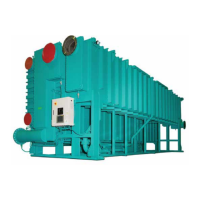JOHNSON CONTROLS
36
FORM 155.30-ICOM2.EN.UL
ISSUE DATE: 12/21/2018
SECTION 3 – HANDLING, STORAGE, INSTALLATION AND REASSEMBLY
4. Make the outer covering, anged parts, and evap-
orator water chamber casing easily removable to
facilitate servicing.
5. The points that require hot insulation or cold insu-
lation are shown in Table 7 on page 39 36.
6. The casing of the absorber and the condenser wa-
ter chamber does not require hot insulation or cold
insulation. If insulation is used, make it easy to
remove.
HOT INSULATION AND COLD INSULATION
PROCEDURE
1. The recommended materials and their thickness
for hot insulation or cold insulation are shown in
Table 5 on page 36.
2. Use a bonding agent, iron wire, iron band, or other
aproved bonding agents to x the hot insulation/
cold insulation material. Never rivet them. The
use of welding pins is not permitted.
TABLE 5 - INSULATING MATERIAL AND THICKNESS
HOT INSULATION COLD INSULATION
Material Rock wool or glass wool Polyurethane foam, polystyrene foam, or glass wool
Thickness 2 inch 2 inch
TABLE 6 - POINTS REQUIRING HOT OR COLD INSULATION
POINT REQUIRING HOT
INSULATION
POINT REQUIRING COLD INSULATION
POINT THAT MUST NOT BE
HEAT-INSULATED
Generator Shell Evaporator Shell Sight Glass
Generator Water Chamber Casing Evaporator Water Chamber Case Valve Manipulator
Solution Return Piping Refrigerant Piping Pressure Gauge
Heat Exchanger
Refrigerant Blow Piping Thermometer Insertion Hole
Valve for Vacuuming (factory
recommended only)
Relay Insertion Hole

